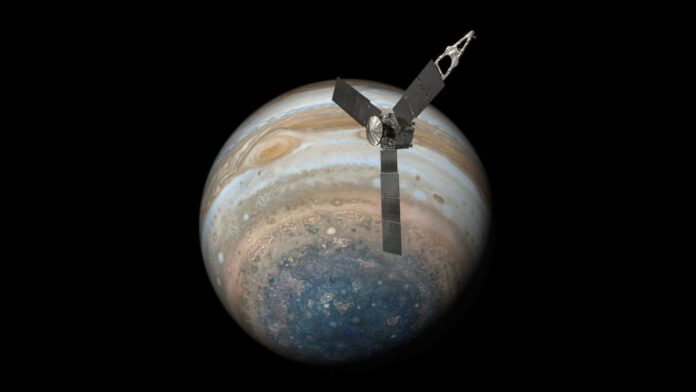Good news! NASA’s Jupiter explorer Juno’s memory is back online, and most of the precious images of the gas giant and its volcanic moon Io the probe took just before that glitch hit have been salvaged.
Juno gave its operators a little headache after its memory, packed with priceless images of Jupiter and its mysterious volcanic moon Io, became inaccessible just before a close pass Juno made of the two bodies in mid-December.
But all is well now, NASA announced on Tuesday (opens in new tab) (Jan. 10), and stunning views of both Jupiter and Io are flowing down from Juno to NASA’s ground-based control centers.
The anomaly in the computer system that stores Juno’s data was first detected on Dec. 14, one day before Juno’s first close glimpse of Io. At that time, NASA kept the information under wraps, but as the agency revealed later, on Dec. 17, only two days after the Io imaging campaign, the entire probe was put into protective safe mode, with only the most essential systems powered on.
NASA has now revealed that, since Dec. 29, Juno has been fully back on, with its memory mostly intact.
Related: Something weird is happening in Jupiter’s atmosphere, 40-year study shows
“As expected, the majority of the science data collected during the flyby (including all data related to Jupiter’s moon Io) was successfully received, and only a small portion was corrupted by the anomaly,” NASA said in the Tuesday statement. “Instrument recovery activities are now complete, and the spacecraft is functioning nominally. Juno’s next flyby of Jupiter will occur on Sunday, Jan. 22.”
Juno makes periodic swing-bys just 2,600 miles (4,200 kilometers) or so above the tops of Jupiter’s thick, swirling clouds. The computer glitch occurred just as the probe was making its 47th close approach to the planet, which led engineers to believe that the strong magnetic fields surrounding Jupiter may have been responsible for the problem.
The recovery operation involved rebooting Juno’s onboard computer on Dec. 17 and a gradual restoration of the memory downlink.
“The remainder of the science data collected during the flyby is expected to be sent down to Earth over the next week, and the health of the data will be verified at that time,” NASA said in the statement.
Juno, which launched atop an Atlas V rocket in August 2011, has been orbiting the largest planet of the solar system since July 2016. The solar-powered probe successfully concluded its primary mission in July 2021, notching many achievements, including the discovery of a dynamic atmospheric weather layer extending beyond the clouds and determining that Jupiter has a strange oversized core of diluted heavy elements.
Juno’s extended mission, which is expected to run through to 2025, will focus more closely on the four big Galilean moons of Jupiter: the ice-covered Ganymede, Europa and Callisto that harbor potentially habitable subsurface oceans, and Io, the most volcanic body in the solar system.
The probe will perform a total of nine flybys of Io in the coming year, acquiring high-resolution images of the magma-encrusted world for the first time. Two of these flybys will take Juno within just 930 miles (1,500 kilometers) of Io’s surface.
Follow Tereza Pultarova on Twitter @TerezaPultarova. Follow us on Twitter @Spacedotcom and on Facebook.

